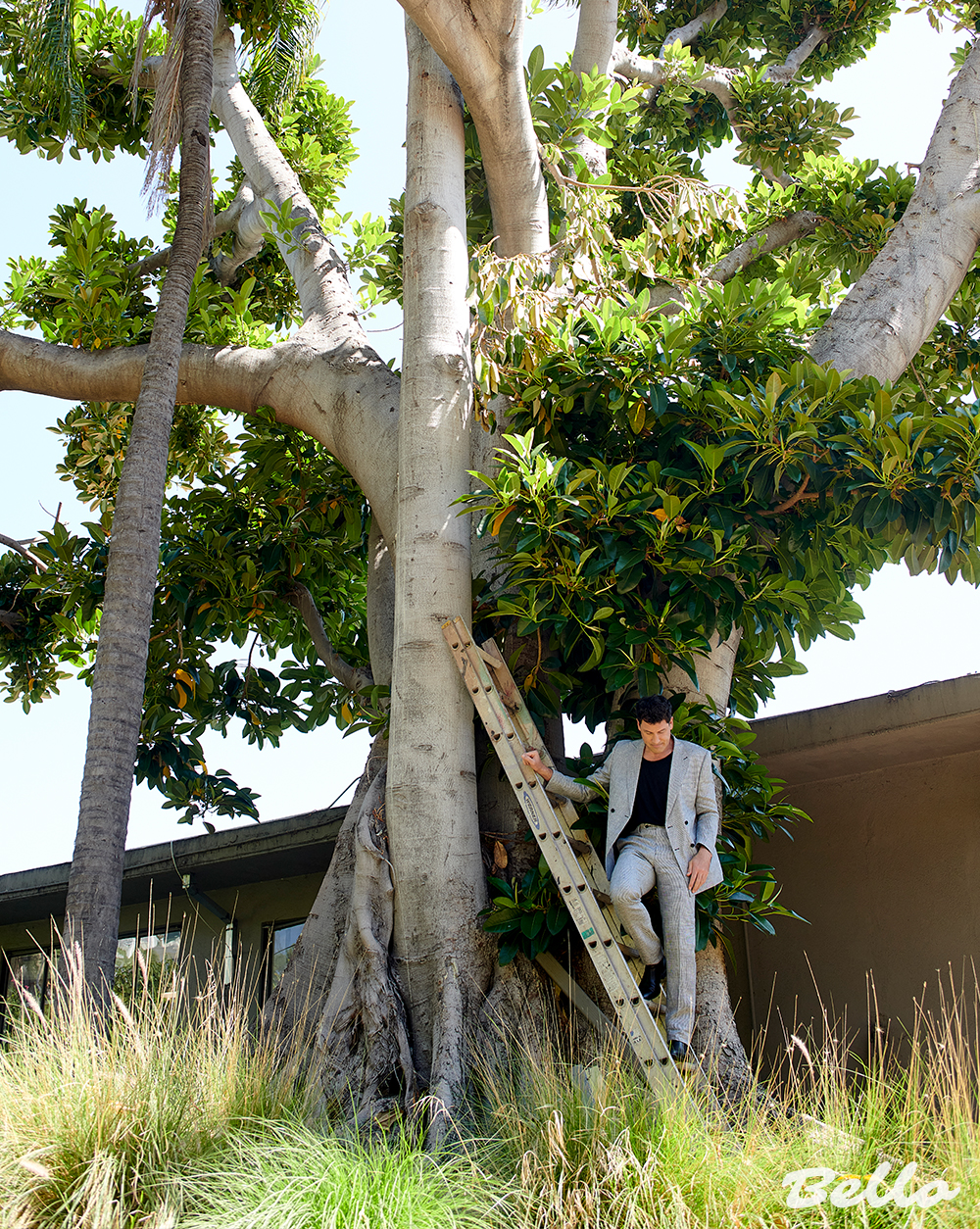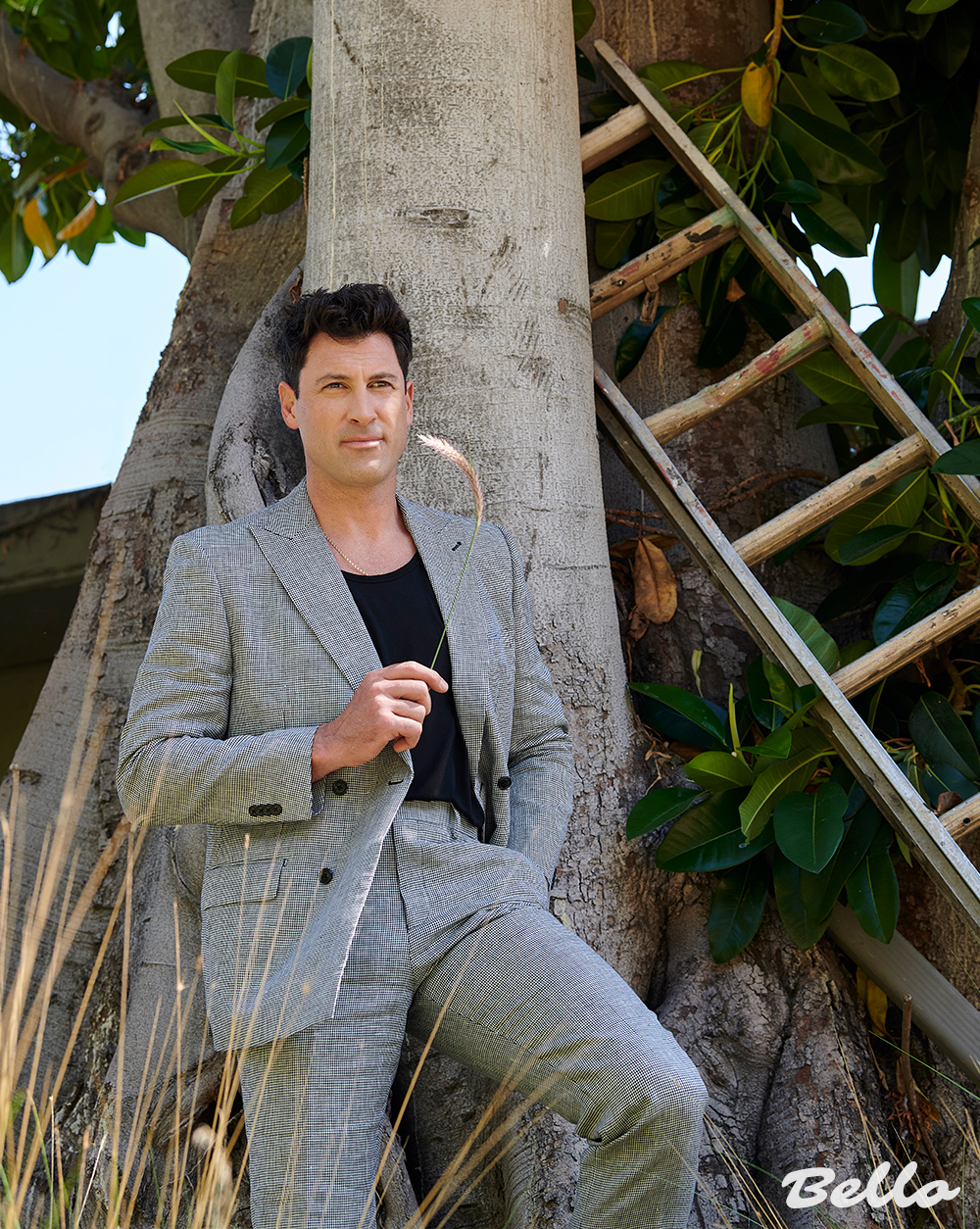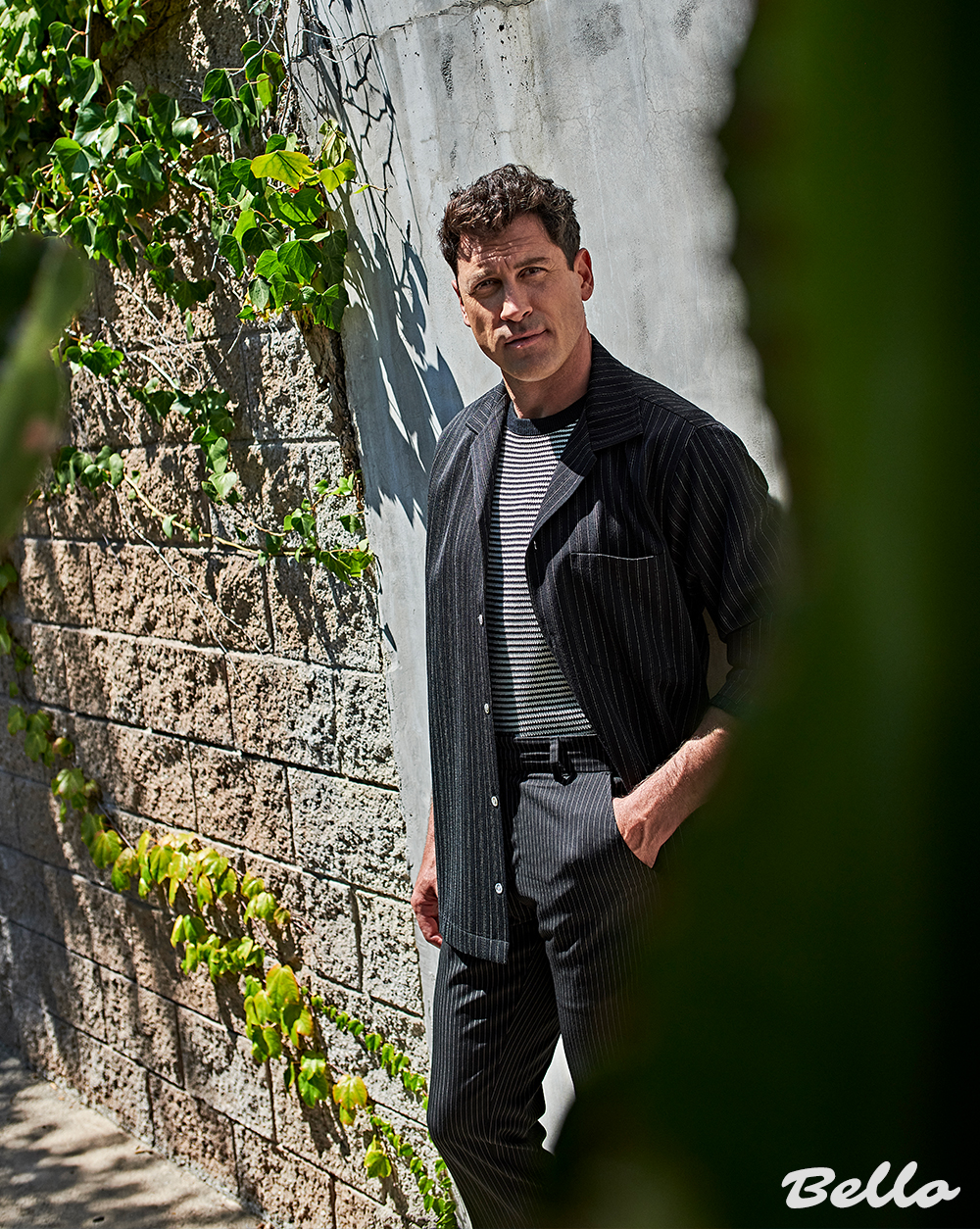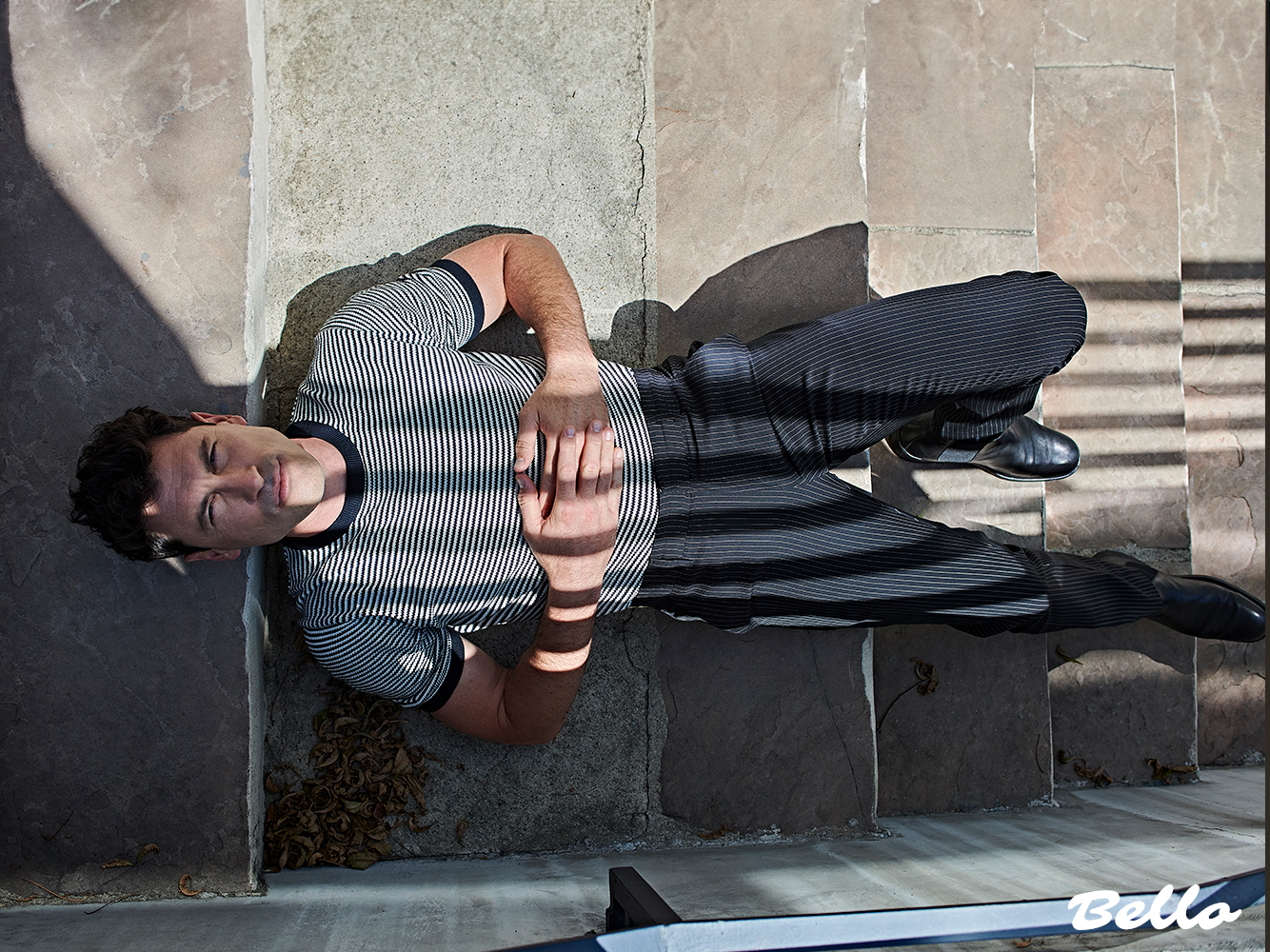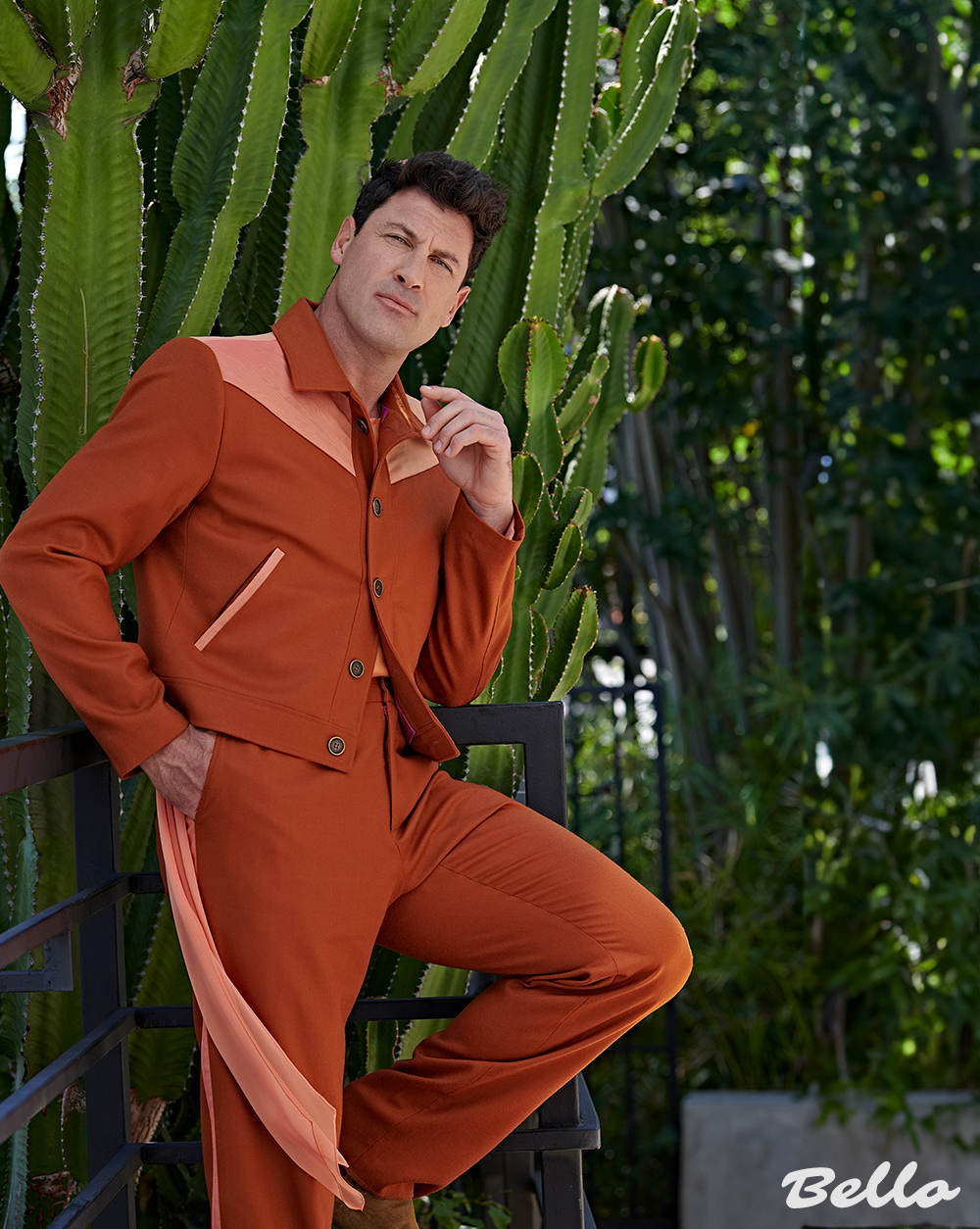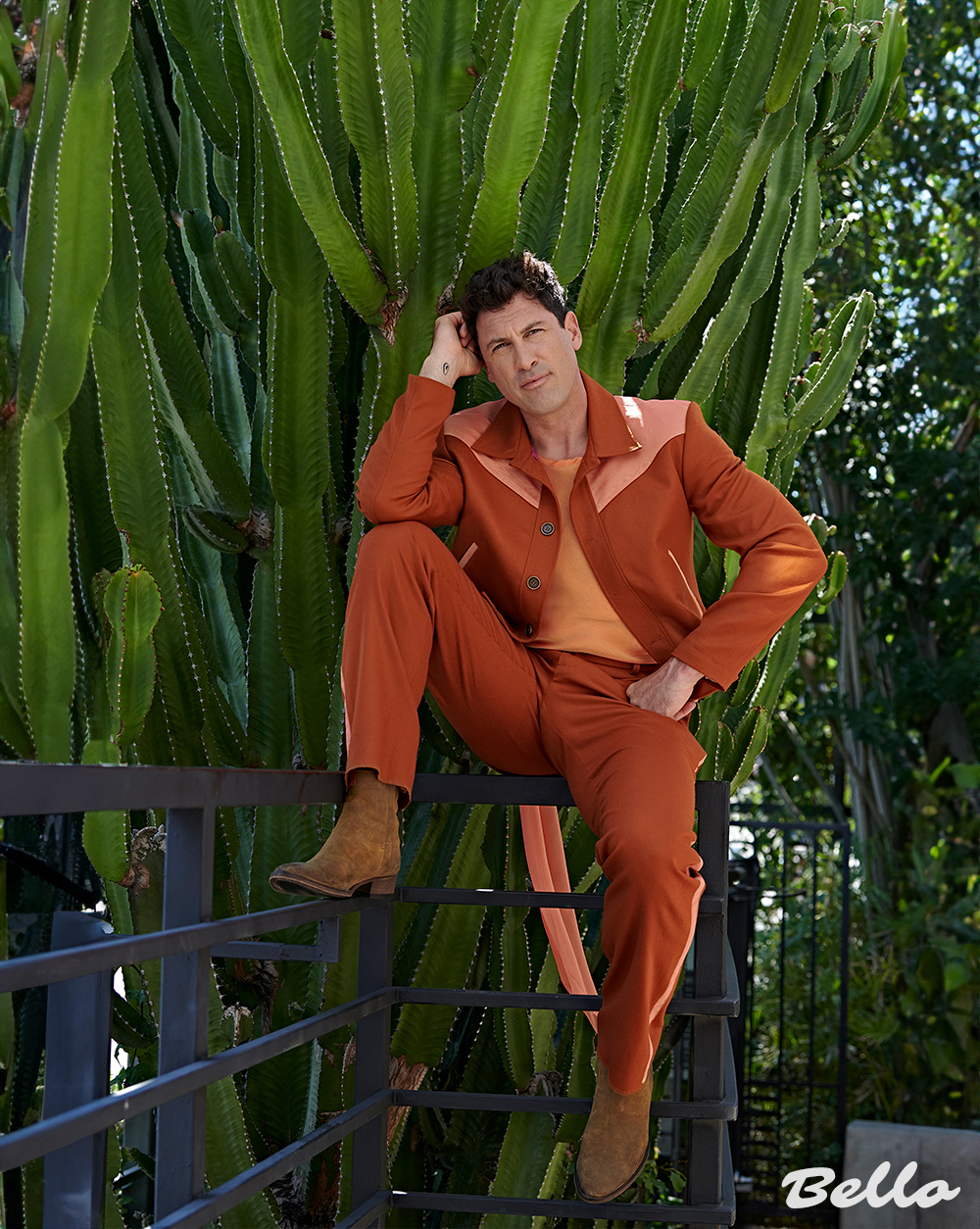Maksim Chmerkovskiy
Los Angeles; the sun is beating down and it’s most definitely t-shirt weather. Not for Maksim Chmerkovskiy though; he’s outfitted in a heavy coat and pants as a part of a photoshoot for the cover of Bello Mag. Even in the jacket he’s cool, calm, and collected. Even in this sweltering heat, he exudes an air of cool, calm, and collected professionalism. There isn’t a hint of complaint, a testament to his seasoned experience, having previously worked on various sets. While this outdoor location may differ from the controlled stages of Dancing with the Stars, where he’s honed his craft, one thing I’ve gleaned from my dancer friends is their need for ample space to showcase their talents.
In fact, everything about this day is kind of not what Maksim is used to. For this cover shoot, he’s on camera (he’s definitely used to that), but as he mentions later in our conversation, he’s not used to dressing up for a photoshoot. He’s used to being on video, performing amazing choreographies for thousands and even millions of people. However, despite his popularity that he has amassed over his 17 seasons on Dancing with the Stars, he’s not here for anything dance related. The purpose of this photoshoot and this day with him is to celebrate his new vodka, Tetya Kapa.
The journey towards the production of Tetya Kapa came organically while he was doing a residency performing in Napa Valley. While performing there, he started meeting locals and two of these locals were vintner Ian White and Arthur Hartunian, owner of Napa Valley Distillery, the only distillery in Napa Valley. Being a Ukraine born man with this newfound relationship with Napa Valley, he seeked to develop a product that encompassed both of these relationships.
“Ukraine was always the breadbasket of the USSR.” Max explains. “Even now with all the stuff that’s going on over there, one of the central focal points is the grain of Ukraine being exported out. So it was the grain to represent my past and because of the culture of drinking and consuming alcoholic beverages to begin with. The vodka is actually a proprietary blend; its 65 percent grain and 35 percent grape. The grape is a sauvignon blanc from the napa valley region, so that combination to me really represents my journey.”
He pauses a moment, reflecting on his journey of releasing his product. “A lot of eastern european culture of celebration revolves around taking a shot of vodka and saying something. Whatever it is, there’s always a toast involved and there’s always a cheers and it’s a very important part of my culture.”
Maksim’s reasoning for releasing this product was not driven by money or anything superficial. It was a pure reflection of the friendships he made in Napa Valley, paying homage to his home country. His decision to make vodka in the heart of wine country was unexpected, but the reasoning was an amalgamation of his life experiences.
Tetya Kapa isn’t the only thing that’s smooth, the production of it was as well. This journey towards the end product was actually very stress-free, which was a first time for Maksim. This was due to the unique process in which Tetya Kapa came to be.
“I actually didn’t see this product in my head at the end of it,” Maksim starts. “I started this process only because of the people involved and I never used to do that. I’ve never done this before. I would first want to know what I want, and then I would build personnel around that project. This time, it was the relationship that happened first and then it was an easy transition into the product and the speed in which everything came up.”
Even the name and label of the product were thought of on the spot. The name ‘Tetya Kapa’ pays homage to the nickname of his aunt, the one who introduced him to art and culture of drinking, and the label was made by an artist who refused payment. “Everything about this project was interesting and different and special and the end result also shows itself too. It’s a gorgeous product, very high end. I’m very proud of it.” Maksim triumphs.
However, although the production of Tetya Kapa ran smoothly, the rest of the summer proved to be hectic. Just ten days after leaving for the residency, Maksim’s second son was born. “I was flying back and forth,” Maksim laughs. When I ask him how he handled traveling all the time while having to perform constantly, he responds, “[This job] requires a lot of creative flex, but also physical flex. And as an artist you never know when your physical flex will start to fade. It was a very telling experience about the state I am in at the moment and what this kind of body represents for me and my future in this career.”
Even within the chaos of it all, Maksim was still able to find time to reflect and take away from this not so ideal situation. “You find a couple days of being in your own thoughts, so I had a lot of time to process the birth of my child. It was a lot of self growth. It was a great summer and a great project to evoke a lot of these types of feelings.”
This revelation by Maksim serves as a constant reminder that parents are going through life for the first time too. Children tend to grow up thinking their parents are perfect, idolizing them for their strengths and blind to their faults. Maksim reminds us that parents are not perfect; they are on this continuous journey of figuring themselves out with us, so for him to acknowledge this in the midst of a new residency and launching a new product, speaks leaps and bounds about his character.
As Maksim mentions, the residency was a great project to evoke feelings of self-reflection and growth. The birth of his son and his time away from home allowed him to reflect and think about what his future in the industry may look like. Even as he is getting older, his commitment to healthy living allows him to continue to pursue this artform he loves.
This commitment to work can be traced back to his experience immigrating to America and witnessing his parents’ bravery to do so. I, like many others, have parents that immigrated to America in order to provide a better life for their children than they had growing up. At the core of these similar shared experiences is work ethic.
Maksim’s parents immigrated to Brooklyn when he was just 14 years old. Even through immigration, Maksim is grateful that his parents allowed him and his brother to pursue their interests. “Our parents did a phenomenal job in making sure we didn’t lose touch with all the things that are important, even during the process of immigration. I’m like damn, I don’t know how you guys did it.” he praises. Right from the start, all he knew was work. “It just became constant; school was a lot of work, dance was everything, business was a lot of work, making money to pay rent was a lot of work, but also if you want some more, you have to work a little more. I mean that life was tough.” Maksim shares, remembering the struggles he faced when arriving in America.
However, it’s this experience; to have your hand forced into the fire, that allows Maksim to dive headfirst into any opportunity he can. He knows what it takes, he’s been burned before. “If nothing else, we know that very well. So, if I’m taking on something later in life, passion is allowed because it’s not just work, work, work,” Maksim starts. “I feel like I can go and work headfirst and if I sprinkle some passion and some interest into that, I mean that’s the winning formula right.” His experience being forced to work harder than everyone else since he was young has served as a very useful foundation for his interest in pursuing other ventures in his life that he is passionate about, from competition life, to Dancing with the Stars, to producing his own vodka. “Any entrepreneur will tell you you only have to succeed once. So for me, it’s not about the success rate, it’s about the doing rate. My doing rate is through the roof.” he shares insightfully.
Maksim’s work ethic comes from witnessing his parents immigrate in their mid 30’s to America and watching them struggle to provide a better life for their children. Because of this, Maksim has achieved more than most people, including the impossible for those of us who have immigrant parents – making them proud (I’m only partially joking).
That’s what all parents want to do anyways, provide a better life for their children, Maksim included. “There’s a lot of work to be done in terms of their fundamental core values and instilling those to me is so much more important. Numbers and letters to me are so important.” Maks shares, when asked if he would want his children to pursue dance like him and his wife. His eldest son is in dance, but also tennis, soccer, gymnastics, and karate. Maksim knows the importance of instilling values and an educational foundation first and foremost. He also knows his son doesn’t want to do dance, until recently.
“He brought me a paper yesterday – he’s in first grade and the first week he went and drew all the things he loves and there’s a tennis racket, a soccer ball, and a dancer that he asked mom to help him trace and he colored it in and it was great. I was like ‘I thought you don’t like dance?’ and she’s kicking me under the table.” he laughs. He becomes more serious and heartfelt for a moment. “Honestly, you do your best trying to raise good people and why would I force him? What if he’s not meant to be that? Let him find himself.” he finishes.
Maksim has a very hands-on approach with his children, but not in the way that many of us are used to. He is hands-on in their lives in the way that he knows what their interests are and how
they feel about them. “Whichever one you decide to pick, you pick it and then I’ll support that.” he shares genuinely.
Even though dance may not be a huge part of his son’s life, Maksim can’t say the same. Having his roots in competition life since his childhood, he made his debut as a professional dancer for Dancing with the Stars for season 2 in 2006. However, competition life and Dancing with the Stars proved to be very different. “For dancing with the Stars, you just gotta pull it off once. Because it’s not like lets see this person perform for three months, five shows a week. You don’t need to be a professional dancer to pull off a professional looking performance.” he explains. The premise of Dancing with the Stars is having non-professional dancers perform. This can be challenging for the professional dancers on the show, who are used to dancing with fellow professionals.
“The difference between Dancing with the Stars and stage performances is that if I’m on stage, I’m with a person who’s ready to be here at this moment in the professional life of a performer.” Maksim says. “In Dancing with the Stars, I’m with an amateur who is terrified and may or may not actually pull it off. I’ve had performances where she was going to do amazing and then we slipped and she couldn’t recover. Or she stepped in her dress and she wasn’t able to maneuver in it like I would with a pro. That’s why the show is live and intriguing because you never know.”
Maksim danced with non-professionals for 17 seasons on Dancing with the Stars. Throughout the years, he’s had to deal with more than just some inexperienced partners. “There’s all kinds of filming, all kinds of preshoots, all kinds of rehearsal time, it’s nuts. You don’t have a private space with all this around you and it’s not a lot of people’s cup of tea.” Maksim says. Because of this, relationships between contestants can become strained. Maksim shares that he would have gotten along a lot better with several of his partners if they weren’t on the show better. The added stress that comes with the show just took a heavy toll on their relationship.
However, some of his iconic partnerships stand out to him out of his 17 years on the show. “I think it’s whatever evokes whatever feelings come up at the moment. I’ve had 17 seasons.” Maksim says when I ask him if any particular seasons stand out to him. “Kirstey Alley’s seasons both stand out obviously. It was one of my favorite partnerships, but also one of the more famous Dancing with the Stars partnerships. She was an amazing on camera personality, but she was also an amazing friend. The season that I won with Meryl Davis obviously holds a special place in my heart because it was the only time I won, but also because of the nature of the win and how dominant that partnership was for me.”
Maksim’s partners aren’t the only factor in what he takes away from a season and how memorable it is. He shares that a season could be very memorable and it could be due to something unrelated to his partner. “It may have to do with something else that has been happening at the same time as the season. We also live a life, you know, we don’t just come and turn off for three months.” he says.
Sometimes as a consumer of celebrity-related content, it can be easy to forget that these figures we see on the screen are actual real people (I admit that I’ve been guilty of this). They have
their ups and downs like the rest of us and what we see on screen is not a true depiction of everything they are. It can be easy to idolize or vilify a person from what we read about them, but Maksim reminds us that they all have a life outside of what is portrayed.
After 17 seasons on Dancing with the Stars, he announced that he was done participating as a dancer five years ago. “Is that door completely closed and if you would want to return, what capacity would that be in?” I ask him.
He’s silent for a moment, thinking. “It’s very hard to have longevity,” he says truthfully. “I started shooting myself in the foot towards the end and I was also hurt, no pun intended,” he chuckles. “I was on a journey since 2012 to discover all the areas I have on my body so that I can catch up. I was on that trip of getting myself back to where I can be better than I ever was and I feel like I am. I feel like I’m in that mode to be able to perform on a high level and present high level art.”
I sit and try to hide my surprise, unsure if this is him announcing a potential return. Sensing this, he clarifies. “I’m thinking about a lot of other things,” he says. “I am so much more in touch with the art of dancing now as opposed to the art of making money in Hollywood. Right now, for the art of it, yeah let’s do it, but for the commercial part of being someone else’s crutch for three months while they are finding themselves in a very difficult position of having to learn ballroom dancing for live TV, I’m not sure if that’s something I want to do passionately.”
Maksim has already done that enough. He’s more focused on the art and passion of dancing now, as opposed to the commercial appeal of it. “Dancing with the Stars has fulfilled itself and I’m grateful for it,” he finishes. “Also I’m watching my wife, my brother, and his wife on Dancing with the Stars, so it’s enough.”
Maksim’s personality allows him to easily live vicariously through his loved ones. Having the closest people in his life still performing on the show, he’s able to fill whatever gap he may or may not have from leaving the show.
Although he may be finished with the show, he’s taken with him many memories, including some scary ones. One of these moments came shortly after getting his first tattoo. He shares a scary (albeit hilarious) story of having to hide his tattoo from his mother after his brother warns him too late about her reaction.
“I have to perform and rip my shirt off, Lenny Kravitz style. I got the wardrobe department to put a bunch of tattoos on me and they’re like ‘why do you need to do this to yourself?’ I was like ‘Yo, the American flag right here and an eagle right here and some barbed wire, I just want everything.’ It was awesome, I said just put on all this stuff, so she can’t tell which one is real. She’s like ‘What is all this?’ and I’m like ‘it’s all fake stop don’t worry about it.’”
A good amount of us have probably dealt with the backlash of immigrant parents finding out that we have tattoos. I played it safe and moved to college right after I got mine in order to give them time to process the atrocities I had done to my body (their words, not mine).
I ask him if there’s any costumes that stand out to him or if he has any favorites throughout the years, a question he’s surprisingly never been asked before. He pauses, replaying all the costumes he’s had over the years in his head. “We have a lot of Disney week characters and those are fun,” he says. “Halloween week is fun to dress up. Character dances are always fun.”
Our conversation naturally transitions into the realm of fashion and his outlook on it. “You have to not use fashion to camouflage, to not use fashion to hide behind or present yourself as not who you are,” he says. “Because then it’s just too much makeup. You have to use fashion to enhance who you are and a lot of people have a huge disconnect with that.”
Maksim explains that fashion should be a self-representation of who you are and that a lot of people get caught up in the aspect of fitting in that they abandon their true self. “I like fashion when you find what your fashion is. Not everybody should be dressing up in couture. I think that somebody’s fashion can look different because you actually feel your aura is better when you put on sweatpants.”
Trends have come and go as fashion has evolved throughout the years. We went from skinny jeans to ultra baggy pants, tops that emphasized logos and graphics to tops emphasizing the fit and cut, sneakers that encompassed the entire color wheel to just a simple black leather boot. However, Maksim’s style has remained relatively unchanged since his first debut on Dancing with the Stars. “The fashion didn’t change for me, I was always a dancer,” he explains. “I realized very early on that if I maintained my body where its shape is great, my six pack will always be in fashion.” Maksim’s outlook on self-representation emphasizes his physical appearance. However, that’s not to say he doesn’t indulge in consumerism when it comes to certain parts of fashion. “I think sneaker culture pushed [the fashion industry] to a different stratosphere because now people are able to use the sneaker to build the rest,” he shares. “Sneakers allowed people to walk on the red carpet wearing sneakers. I love that about sneaker culture. I think it gave a lot of people a lot of opportunities. Off white popped off and Pharell is running Louis. It’s awesome.”
He’s not wrong. The prevalence of sneakers in the 2010’s opened up so many doors for designers in order to get their foot in the door of high fashion houses, whereas the two industries were completely separated before. We had the late Virgil Abloh and Pharell run Louis Vuitton, one of the most famous fashion houses in the world, even though their roots in streetwear. We had collaborations with large powerhouses from both industries, including Nike x Off White, Louis Vuitton x Supreme, and Raf Simons x Adidas. Most importantly, this union between the two industries opened up opportunities to create art for those who would not have gotten the chance without the union. Sneaker culture and streetwear culture is rooted in Black culture and this union allowed them to share their art with the entire fashion industry and be relatively accepted by the masses. Whether you have good or bad opinions about a certain
designer, you would not have gotten the opportunity to have an opinion about that designer if the streetwear and high fashion industry never merged together.
Maksim finishes by again emphasizing the importance of self-representation. “I think fashion to me is extremely important. You have to self represent. I realized you are at your best when you are honest with yourself. You know, you feel different, you act different, you look different, you present yourself differently.”
And that’s just who he is, an honest man, in all areas of his life, whether it’s fashion, work, or parenthood. Maksim is just like the rest of us, navigating through life for the first time. As his chapter with Dancing with the Stars closes, he’s excited to flip the page and focus on other entrepreneurial ventures, raising his second son, and continue to do what he loves, perform.
Photography NINA M DUNCAN @ninamduncan
Creative Direction ALEKSANDAR TOMOVIC @alekandsteph
Styling MICHAEL FUSCO @mikeystyles
Grooming DANNI KATZ @dannidoesit
Junior Producer / BTS ISABELA COSTA @isa.chromatic
Interview ROBBY WONG @shehatesrhude
Special Thanks @agpr_communication
Production BELLO MEDIA GROUP X MAISON PRIVÉE @bellomediagroup x @maisonpriveepr_la

